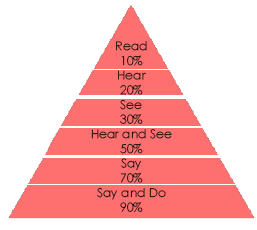Dale’s Cone of Learning
After 2 weeks, we remember
10% of what we read…………………………… Reading
20% of what we hear…………………………… Hearing Words
30% of what we see……………………………… Looking at Pictures
50% of what we hear and see……………… Watching a Movie
70% of what we say……………………………… Giving a Talk
90% of what we say and do…………………… Doing the Real Thing
Literacy Activity
In parent book, have parents do “What’s your learning style.” List on the board how many are auditory, visual, kinethetic learners.
Discuss.
Media Literacy
In today’s information based economy, reading is both an essential skill and a simple pleasure however; many children are
growing up hooked on TV. At present, North American children spend four times as many hours watching TV as they do reading
for pleasure and unfortunately, most TV is a passive activity. Even if we feel strongly about limiting TV viewing, children are
exposed to some TV.
Text is essential for building literacy skills. Successful readers have broad, strong vocabularies. TV is all talk, however, without many useful words. The average children’s book comes with a greater vocabulary set than most prime time TV shows. The act of reading fosters habits of analysis, questioning, comprehension and rationality. TV fails to contribute to the development of these key skills. Children who read for pleasure score 10% higher on proficiency tests than those who never read for fun.
We suggest that you limit TV or media time (sometimes called screen time). They all mean the same thing. Begin with some rules. Your child must have an equal amount of reading time versus media time (that includes computers). Be clear about what programs children are allowed to watch (or what games to play on the computer).Remind children that TV is not real. If they are scared, they can turn it off.
